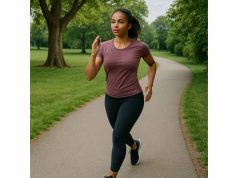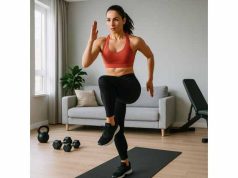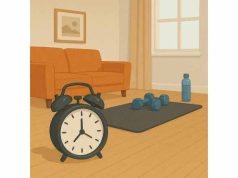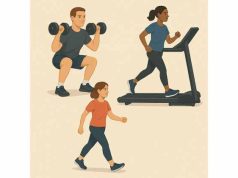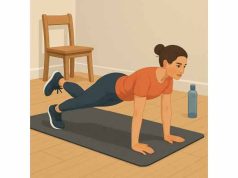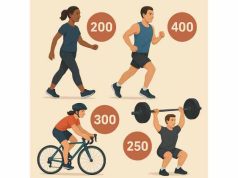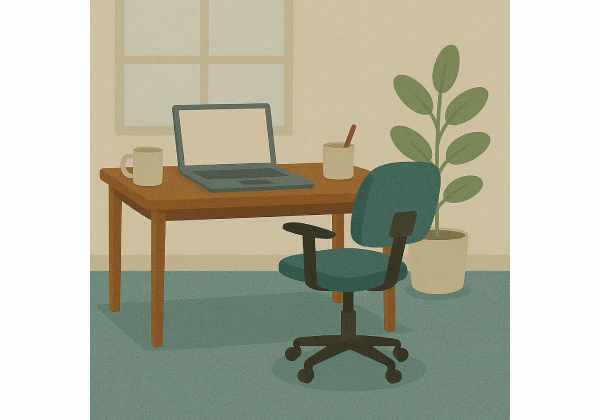
Long hours at a desk do not have to work against your health. With a clear plan, you can turn everyday moments—walking to a meeting, pausing between emails, filling your water bottle—into meaningful activity that protects your joints, supports energy, and helps weight management. This guide shows you how to combine step targets, purposeful breaks, and short “micro-workouts” into a routine that fits the workday. You will find practical templates, time estimates, and quick options for cramped offices or busy call blocks. If weight loss is also a goal, pair this plan with structured training and nutrition. See our brief overview of strength, cardio and steps guidance for context.
Table of Contents
- What a desk job movement plan does
- How many steps to aim for
- Breaks that actually help
- Micro workouts you can do
- Mobility and strength essentials
- Ergonomics pain and common barriers
- Weekly templates and trackers
- Frequently Asked Questions
What a desk job movement plan does
A desk-job movement plan is a simple system that redistributes the same workday minutes into health-promoting activity without hurting productivity. It blends three levers:
- Steps—your daily movement baseline that keeps metabolism and mood steady.
- Breaks—brief, scheduled interruptions of sitting that restore focus and reduce stiffness.
- Micro-workouts—1–5 minute bouts that build strength or mobility with minimal sweat or equipment.
Most desk workers are not “inactive”; they are under-distributed. Long uninterrupted sitting compresses movement into small pockets before and after work. Spacing activity through the day improves circulation, reduces back and neck tightness, and can raise non-exercise activity thermogenesis (NEAT), the calories burned outside of formal workouts. Over a week, those small changes add up.
Think of this plan as scaffolding, not strict rules. The aim is to make movement automatic and low-friction—tied to tasks you already do. For example, stand and pace for every phone call; walk the long route to the restroom; set a two-minute timer after you hit “send” on a major email. These anchor points turn theory into habits you can keep during busy seasons.
Here is the high-level structure you will implement in the following sections:
- Define a realistic step range that matches your time, terrain, and goals. You will learn quick ways to earn 500–1,000 steps in short windows.
- Install a break schedule that fits your meeting pattern and focus style, so your spine, hips, and eyes get relief without constant interruption.
- Slot 1–5 minute micro-workouts at natural edges—before lunch, after long calls, as you boil water for tea—to maintain strength and mobility between gym sessions.
This plan also respects recovery. Extended deep-work blocks are important. You will use flexible ratios (for example, 55 minutes work, 5 minutes up) and “bank” breaks when you cannot move during a presentation. If weight loss is part of your objective, weave these habits into safe weight-loss basics and a consistent training plan, rather than relying on steps alone.
Expect the first two weeks to feel experimental. By week three, most people settle into a personal rhythm: predictable step bursts, a preferred break cadence, and three or four micro-workouts they can do anywhere. The result is a workday that supports your health by default.
How many steps to aim for
Step targets are a practical anchor for office workers because they translate to time and distance you can parcel across a day. Instead of fixating on a single number, use a flexible range tied to context and goals.
Set a personal baseline. Track a normal week without changes to learn your current average. For many desk-based adults, that sits between 3,000 and 6,000 steps. Set your initial goal at baseline + 1,500–2,000 steps. After one to two weeks, nudge your range upward by 500–1,000 steps if it feels comfortable.
Choose a range, not a ceiling. For general health, aim for 7,000–10,000 steps most days. For weight management, many find 8,000–12,000 steps effective when paired with nutrition. Tall people and brisk walkers accumulate steps faster; shorter strides and slow indoor laps may need more minutes to reach the same count.
Translate steps to minutes. A decent rule of thumb is 100 steps per minute at a purposeful pace. Ten minutes often yields around 1,000 steps; five minutes, roughly 400–600 depending on stride and terrain. Use this to budget “step bursts” into your calendar: two 10-minute walks plus four 5-minute office loops can net 4,000–5,000 steps without leaving the building.
Place steps where they stick:
- Morning primer: 8–12 minutes before opening email.
- Midday lap: 10–15 minutes after lunch to counter the slump.
- Afternoon reset: 5–10 minutes between deep-work blocks.
- Evening unwind: 10–20 minutes, solo or with family.
Meetings as miles. Turn camera-off calls into pacing time. Even slow hallway loops or stair shuttles add up. For camera-on video meetings, stand for part of the call or shift to a leaning posture.
Under-desk devices and walking pads. If policy and space allow, a compact walking pad at 1.5–2.0 mph can deliver 2,000–3,000 steps per focused hour. Use it for email triage and non-design tasks; step off for precision work that needs still hands.
Weekend wobble. Keep a “floor” for rest days—perhaps 6,000–7,000 steps—so Monday does not feel like starting over. On active days, keep the upper bound reasonable, especially if your joints object to large sudden spikes.
If you want more detail on walking as a tool for body composition and appetite control, see our concise guide to walking step targets.
Breaks that actually help
Breaks work when they are predictable, short, and matched to the kind of strain you accumulate. Sitting loads the hips and lower back, narrows breathing, and tires the eyes. Good breaks reverse those positions without derailing momentum.
Pick a cadence that fits your work:
- 55–5 method: Work 55 minutes, then move for 5 minutes. Ideal for deep work and longer focus arcs.
- 30–2 rule: Every 30 minutes, stand and move 1–2 minutes. Suits call-heavy schedules and managers who switch contexts often.
- Pomodoro variant: 25 minutes on, 5 minutes off; after four cycles, take 10–15 minutes up and out.
Use break “stacks.” Each break should quickly counter the last hour’s posture. A sample stack: stand, inhale through the nose for 3 slow breaths, walk 60–90 seconds, then perform 6–8 hip hinges or desk push-ups. If your neck or upper back feels tight, add band pull-aparts or a 30-second chest stretch in a doorway.
Protect your eyes. Apply the 20-20-20 guideline: every ~20 minutes, look at something 20 feet away for 20 seconds. If you wear glasses, keep lenses clean and consider reducing overhead glare. Many find this helps headaches and maintains focus late in the day.
Bank and borrow. During presentations or long customer calls, you may skip scheduled movement. Bank those minutes and “repay” them with a 10-minute walk afterward. The point is consistency across the day, not perfection every hour.
Automate the cue. Use a simple timer or your watch’s move alert. Set a water goal and keep a bottle across the room to force micro-walks. Put a sticky note on your screen with your break stack: “Stand – Breathe – Walk – Hinge – Stretch.”
Make breaks part of NEAT. Breaks are not tiny workouts; they are maintenance. They live alongside the non-exercise activity that quietly increases daily burn and mood. If you want a deeper dive into non-gym movement, review our overview of NEAT.
Respect focus. If a 30–2 rule fractures your concentration, change the ratio—try 90–7 or a mid-morning/afternoon 10-minute lap instead. The best plan is the one you keep.
Micro workouts you can do
Micro-workouts are short bouts (1–5 minutes) that build or maintain strength, mobility, and posture with minimal setup. They complement, not replace, your gym sessions. Choose two or three that feel natural in your space, keep intensity moderate (you should return to your desk without heavy breathing), and rotate to avoid overuse.
One-minute resets:
- 20–30 marching steps in place + 10 desk push-ups.
- 8–10 hip hinges (hands on hips), slow and controlled.
- 30-second doorway chest stretch + 10 scapular squeezes.
Two-minute posture pack: 30–45 seconds of brisk walking; 10 bodyweight squats; 8–10 band pull-aparts or towel rows; 20-second calf stretch at a step.
Three-minute full-body option: 30 seconds each—reverse lunges, wall push-ups, wall sit; repeat once. Finish with 20 seconds of deep nasal breathing while standing tall.
Five-minute mini circuit: 1 minute brisk walk; 10–15 step-ups (stairs or low platform); 10–12 chair-assisted single-leg squats (5–6 per side); 20-second hip flexor stretch per side; 10–12 desk rows with a sturdy towel looped around a post.
Band and dumbbell add-ons (optional): Keep a light band or a single dumbbell under the desk. Try 2 sets of 12–15 band rows, overhead band pull-aparts, or 10–12 goblet squats with a light weight. If equipment is not allowed, substitute slow tempo bodyweight moves.
Technique cues: Move smoothly, breathe through the nose when possible, and keep joints stacked (ears over shoulders, ribs down, hips level). Use a 6–7 out of 10 effort. If you feel pain, stop and pick a different pattern.
For a slightly longer at-home option you can use before or after work, try our no-equipment circuits and scale the sets down to 10 minutes.
Mobility and strength essentials
Daily micro-workouts keep you moving, but two to three short strength and mobility sessions each week protect your back, neck, and knees from desk strain and maintain muscle while you sit.
Mobility anchors (5–10 minutes):
- Hips: Half-kneeling hip flexor stretch (30–45 seconds per side) and 8–10 controlled hip circles.
- Thoracic spine: Open-book rotations (6–8 per side) and wall angels (8–10 smooth reps).
- Wrists and forearms: Gentle flexor/extensor stretches (20–30 seconds each) and 8–10 fist circles.
- Ankles and calves: Knee-to-wall ankle rocks (8–10 per side) and calf stretch (30 seconds).
Strength pillars (15–20 minutes): Organize around patterns, not body parts.
- Squat or lunge (bodyweight, goblet, or split squat)
- Hinge (hip hinge, Romanian deadlift with kettlebell, or good mornings)
- Push (push-ups, incline push-ups on desk)
- Pull (band rows, towel rows, or doorframe rows with caution)
- Carry or brace (farmer carry with a heavy tote, plank variations)
Minimalist two-day example:
- Day A: Goblet squat 3×8–10; incline push-up 3×8–12; band row 3×12–15; side plank 2×20–30s.
- Day B: Hip hinge 3×8–10; reverse lunge 3×6–8 per side; dumbbell overhead press 3×8–10; dead bug 2×10 per side.
Core and posture: Focus on anti-movement drills (planks, dead bugs, bird dogs) more than endless sit-ups. These protect the spine and make long sitting less taxing. Add 5 minutes of breathing work (long exhales) to reduce neck tension from shallow mouth breathing.
For technique primers and warm-ups that pair well with desk work, see our notes on mobility and recovery.
Ergonomics pain and common barriers
Movement helps most when the workstation is not fighting you. Take five minutes to audit your setup and remove friction that keeps you sitting still.
Simple ergonomic checks:
- Chair: Hips slightly above knees; back supported; feet flat or on a small footrest.
- Monitor: Top of the screen near eye level; arm’s length away to reduce squinting and neck tilt.
- Keyboard and mouse: Elbows close to 90 degrees; wrists neutral; consider a gel rest only for breaks, not while typing.
- Phone and documents: Use a stand to avoid constant neck rotation.
- Movement space: Keep a clear two-meter loop for pacing and a stable wall or desk edge for push-ups.
Pain and modifications:
- Low back: Favor hip-hinge patterns, gentle pelvic tilts, and short standing intervals. Avoid repeated fast toe-touching.
- Knees: Use partial-range squats to a chair and replace stair sprints with flat laps. For cardio, choose joint-friendly options such as cycling or elliptical.
- Neck and shoulders: Prioritize pull-aparts, rows, and chest opening. Keep the keyboard close to cut shoulder elevation.
Common barriers and solutions:
- Back-to-back meetings: Insert 5-minute holds on your calendar after every second meeting. Pace during dial-in and recap notes while walking afterward.
- Office culture: Normalize standing by using a neutral script: “I focus better standing—carry on.” Invite others for a quick walk to the next agenda item.
- Travel days: Walk terminal laps and do calf raises while boarding. In hotels, use hallway walks and wall push-ups.
If joint limitations restrict options, see our roundup of joint-friendly cardio options to keep activity up without aggravating pain. Persistent or severe symptoms warrant a professional assessment.
Weekly templates and trackers
Templates make your movement plan predictable. Use one of the following as a base and adjust minutes, step targets, and micro-workouts to fit your role and environment.
Classic 9–5 schedule:
- 8:30: Arrive; 8-minute brisk walk loop (≈800–1,000 steps).
- 9:30: Two-minute break stack: stand, breathe, 10 hip hinges.
- 10:30: Five-minute hallway laps (≈400–600 steps) + 10 desk push-ups.
- 12:30: 12–15 minute walk after lunch (≈1,200–1,500 steps).
- 2:30: Three-minute posture pack: squats, pull-aparts, calf stretch.
- 3:30: Five-minute stair shuttles or outside loop.
- 5:15: Ten-minute unwind walk before commute.
Hybrid or remote:
- Begin with a 10-minute neighborhood lap before opening messages.
- Use the 55–5 method in the morning; walking pad at 1.5–2.0 mph during low-stakes tasks for 30–60 minutes if available.
- Insert a 5-minute mini circuit at 3 p.m. to combat the afternoon dip.
- Close with a 15-minute walk to separate work from home.
Meeting-heavy days:
- Adopt the 30–2 rule between calls. Pace during dial-ins and stretch during agenda reviews.
- Bank missed breaks and repay with a 12–15 minute walk once the block ends.
- Keep one default micro-workout: 10 squats + 10 wall push-ups + 30-second stretch. Repeat twice between clusters.
Simple weekly targets:
- Steps: Choose a range (e.g., 8,000–10,000) for five days; a lower floor (6,000–7,000) on two lighter days.
- Breaks: Minimum four 5-minute movement breaks per workday.
- Micro-workouts: 2–4 per day on weekdays; one full-body strength session on the weekend.
Tracking that does not nag: Use your phone’s step tile and set a single alert at 3 p.m.: “Do I need 1,500 steps before 6?” Keep a sticky note with three micro-workouts you enjoy. Review your week on Friday and adjust one lever (steps, breaks, or micro-workouts) for the next week.
Frequently Asked Questions
How often should I stand up at a desk job?
A practical approach is every 30–60 minutes. Stand, breathe, and move for 1–5 minutes depending on workload. If meetings block you, bank those minutes and take a longer 10–15 minute walk later. The goal is to limit long, unbroken sitting rather than chase perfection.
Do under-desk treadmills or walking pads actually help?
Yes, when used sensibly. At 1.5–2.0 mph you can accumulate 2,000–3,000 steps in an hour of low-cognitive tasks. Step off for precision work. They are a tool, not a requirement; pacing during calls and short hallway laps can achieve similar totals.
What can I do if I cannot leave back-to-back meetings?
Switch to a standing or leaning posture, relax your shoulders, and do brief mobility between calls: 10 hip hinges, 10 wall push-ups, 30-second chest stretch. Pace while dialing in or during agenda reviews. Repay missed breaks with a 10–15 minute walk after the block.
How many steps equal 30 minutes of walking?
At a purposeful pace, a common estimate is ~100 steps per minute. That yields around 3,000 steps in 30 minutes. Individual stride length and terrain can change this by several hundred steps, so use a range and focus on consistency rather than exact counts.
Can micro-workouts replace the gym?
They complement, but do not fully replace, structured training. Micro-workouts preserve posture, mobility, and light strength across the day. Aim to pair them with two to three concise strength sessions per week for robust results in muscle retention, joint health, and long-term progress.
Is sitting eight hours still harmful if I work out?
Regular workouts help a great deal, but long, unbroken sitting still strains joints and reduces energy. Breaking sitting every 30–60 minutes and spreading steps across the day improves comfort and focus. Think “move often and also train,” not “either/or.”
References
- WHO guidelines on physical activity and sedentary behaviour 2020 (Guideline)
- The Acute Effects of Interrupting Prolonged Sitting Time in Adults with Standing and Light-Intensity Walking on Biomarkers of Cardiometabolic Health in Adults: A Systematic Review and Meta-analysis – PMC 2022 (Systematic Review & Meta-analysis)
- Optimal Frequency of Interrupting Prolonged Sitting for Cardiometabolic Health: A Systematic Review and Meta-Analysis of Randomized Crossover Trials – PubMed 2024 (Systematic Review & Meta-analysis)
- Daily steps and all-cause mortality: a meta-analysis of 15 international cohorts – PubMed 2022 (Meta-analysis)
- A systematic review and meta-analysis of the effect of treadmill desks on energy expenditure, sitting time and cardiometabolic health in adults | BMC Public Health | Full Text 2021 (Systematic Review & Meta-analysis)
Important Disclaimer
This article provides general education and is not a substitute for personalized medical advice. Movement and exercise carry risks. If you have pain, dizziness, cardiovascular, metabolic, or orthopedic conditions, or you are pregnant or postpartum, consult a qualified clinician before changing activity. Stop any drill that causes sharp pain or unusual symptoms and seek professional guidance.
Share and Stay Connected
If this guide helped you, consider sharing it with a colleague or friend who works at a desk. You can also follow us on your preferred platform—Facebook, X (formerly Twitter), or others—for practical training tips and new templates delivered in a calm, research-aware format.

